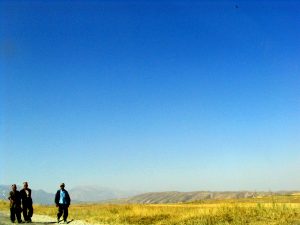Following a successful meeting in July in Andijan, Uzbek and Kyrgyz officials are gathering in Cholpon-Ata this week to continue discussions over the final demarcation of their border.
Kyrgyzstan’s longest border is with Uzbekistan, running 1,314 kilometers around the edges of the famed Fergana Valley. The border features a handful of enclaves, most of them pockets of Uzbek territory surrounded by Kyrgyzstan’s Batken region. Although the Kyrgyz-Uzbek border has been less volatile in recent years than Kyrgyzstan’s border with Tajikistan, it has not been without disputes or incidents in the 30 years since the Soviet Union’s collapse made it an international boundary. For example, in 2015 a Kyrgyz citizen was killed by Uzbek border guards while allegedly trying to smuggle potatoes and apricots out of Sokh district, an Uzbek enclave surrounded by Kyrgyz territory whose population is mostly ethnic Tajik.
As of an agreement in 2017, around 85 percent of the Kyrgyz-Uzbek border was formally described and agreed to. But the remaining border remained undetermined, particularly when it came to the status of the Orto-Tokoi (Kasan-Sai) reservoir and Ungar-Too, a mountain that has served as a flashpoint as recently as 2016.
Deescalating tensions over Ungar-Too was, in fact, one of Shavkat Mirziyoyev’s first actions as acting president in September 2016 after the death of Islam Karimov. He ordered the release of four Kyrgyz workers who had been detained by Uzbek troops and then the withdrawal of Uzbek forces.
Since 2016, Kyrgyzstan and Uzbekistan have continued to engage on border issues. In March 2021, Chairman of Kyrgyzstan’s State Committee for National Security (SCNS or GKNB) Kamchybek Tashiev somewhat prematurely celebrated the complete settling of the border issues. He said after a trip to Tashkent that “[i]ssues around the Kyrgyz-Uzbek border have been resolved 100 percent. We have tackled this difficult task. There is not a single patch of disputed territory left.” He mentioned a number of land swaps that would settle the deal, triggering some frustration and small protests in Osh.
The dramatics aside, Bishkek and Tashkent have continued plodding along toward a final resolution of the border. In May 2022, according to RFE/RL’s Kyrgyz Service, the two sides began to move toward demarcating the border — that is they began discussions on organization and legal issues, moving toward physically marking the border rather than just drawing lines on a map during a meeting.
In July, the two sides met in Andijan and “prepared draft legal and technical documents regulating the process of demarcation.” They signed a protocol and agreed to meet in Kyrgyzstan in August.
As reported by RFE/RL’s Kyrgyz Service, Nazirbek Borubaev, a special representative of the Cabinet of Ministers of the Kyrgyz Republic, said that the two sides “plan to complete the issues on the border with Uzbekistan this year.”
Kyrgyzstan’s most difficult border remains the border with Tajikistan, where last year there was a significant outbreak of violence. Nearly 40 percent of the more than 970 kilometer Kyrgyz-Tajik border is undemarcated.

































